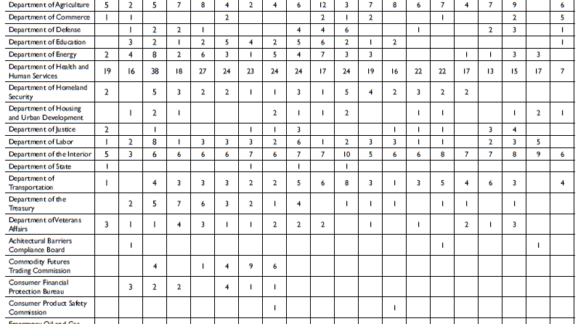Government Accountability Office Database on Regulations
Ten Thousand Commandments 2019 - Chapter 9

Download Chapter 9 as a PDF
The various federal reports and databases on regulations serve different purposes:
- The Federal Register shows the aggregate number of proposed and final rules—both those that affect the private sector and those that deal with internal government machinery or programs—and numerous notices and presidential documents.
- The Unified Agenda depicts agency regulatory priorities and provides details about the overall number of rules at various stages in the regulatory pipeline, as well as those with economically significant effects and those affecting small business and state and local governments.
The 1996 Congressional Review Act requires agencies to submit reports to Congress on their major rules—those with annual estimated costs of $100 million or more. Owing to such reports, which are maintained in a database at the Government Accountability Office, one can readily observe (a) which of the thousands of final rules that agencies issue each year are major and (b) which departments and agencies are producing the rules.[i]
The CRA gives Congress a window of 60 legislative days in which to review a major rule and pass a resolution of disapproval rejecting the rule. Despite the issuance of thousands of rules since the CRA’s passage, including many dozens of major rules, prior to 2017 only one had been rejected: the Department of Labor’s rule on workplace repetitive-motion injuries in early 2001. Since the start of the 115th Congress in January 2017, the CRA has been used 16 times to overturn regulations.[ii] According to recent reports, however, some final rules are not being properly submitted to the GAO and to Congress as required under the CRA.[iii]
Table 10, derived from the GAO database of major rules, depicts the number of final major rule reports issued by the GAO regarding agency rules through 2018. Rules can add burdens, reduce them, implement delays, or set rates and rules for major governmental programs like Medicaid. There were 54 major rules in 2018 based on a search of the GAO’s database (counting the pre-inauguration weeks), compared with 48 in 2017 and 119 in 2016.[iv] The 119 major rules in 2016 under Obama were the highest count since this tabulation began following passage of the CRA, the 100 rules in 2010 had been the second-highest. The 48 under Trump in 2017 was the lowest, followed by 50 in 2003.
This is a good place to summarize the species of significant rules.[v] For example, an economically significant rule is major, but a major one is not necessarily economically significant (so there are fewer economically significant rules than major ones). Both economically significant rules and major ones qualify as significant. Numbers of each over the past three years per various databases appears next.
Completed Major Major
Economically per GAO** Per Unified Significant****
Significant* Agenda***
2016 Obama 83 119 96 486
2017 Trump 88 48 102 199
2018 Trump 35 54 43 108
* From Unified Agenda by (loosely) “fiscal” year; see Figure 20’s completed economically significant rules.
** From GAO database by calendar year.
*** From Unified Agenda.
**** From Federal Register.gov advanced search of “significant” final rules; these may be found at www.tenthousandcommandments.com.
Table 10. Government Accountability Office Reports on Major Rules as Required by the Congressional Review Act,
1999–2018
President George W. Bush averaged 63 major rules annually during his eight years in office. President Barack Obama averaged 86, a 36 percent higher average annual output than that of Bush. Obama issued 685 major rules over seven years, compared with Bush’s 505 over eight years. (The presentation in this report uses calendar years, so Bush’s eight years contain a couple of Bill Clinton’s presidential transition weeks at the top before his inauguration, whereas Obama’s first year would include the Bush administration’s final weeks.) Trump’s 48 and 54 major rules in years one and two respectively mean an average of 51 major rules annually; this is less than his two predecessors, even before taking into account that some major rules are deregulatory.